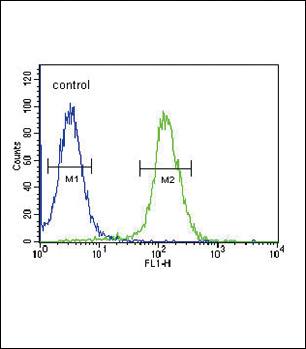

| WB | 1/1000 | Human,Mouse,Rat |
| IF | 咨询技术 | Human,Mouse,Rat |
| IHC | 咨询技术 | Human,Mouse,Rat |
| ICC | 技术咨询 | Human,Mouse,Rat |
| FCM | 1/10-1/50 | Human,Mouse,Rat |
| Elisa | 咨询技术 | Human,Mouse,Rat |
| Aliases | Pro-FMRFamide-related neuropeptide FF, FMRFamide-related peptides, Neuropeptide SF, NPSF, Neuropeptide FF, NPFF, Neuropeptide AF, NPAF, NPFF |
| Entrez GeneID | 8620 |
| WB Predicted band size | 12.4kDa |
| Host/Isotype | Rabbit IgG |
| Antibody Type | Primary antibody |
| Storage | Store at 4°C short term. Aliquot and store at -20°C long term. Avoid freeze/thaw cycles. |
| Species Reactivity | Human, Mouse, Rat |
| Immunogen | This NPFF antibody is generated from rabbits immunized with a KLH conjugated synthetic peptide between 86-113 amino acids from the C-terminal region of human NPFF. |
| Formulation | Purified antibody in PBS with 0.05% sodium azide. |
+ +
以下是关于NPFF抗体的3篇代表性文献及其简要摘要:
1. **"Characterization of antibodies against neuropeptide FF (NPFF) for immunohistochemical use in mammalian brain"**
*Elhabazi et al. (2013)*
该研究开发并验证了针对NPFF的高特异性多克隆抗体,通过免疫组化分析揭示了NPFF在大鼠中枢神经系统中的分布模式,证实其与痛觉调节相关脑区的关联性。
2. **"Differential distribution of neuropeptide FF in pain-processing regions of the rat spinal cord: an antibody validation study"**
*Gouardères et al. (2005)*
作者利用特异性NPFF抗体进行免疫荧光定位,发现NPFF在脊髓背角不同层中的差异性表达,提示其在疼痛信号传递中的潜在调节作用。
3. **"Development of a novel radioimmunoassay for neuropeptide FF using sequence-specific antibodies"**
*Mollereau et al. (2001)*
研究报道了一种基于NPFF C末端序列设计的高灵敏度抗体,建立了新型放射免疫分析法,成功应用于血浆和脑脊液中NPFF浓度的定量检测。
*注:NPFF抗体相关研究多集中于2000-2010年代,近年文献较少。建议通过PubMed或Web of Science以“NPFF antibody”为关键词获取最新进展。*
Neuropeptide FF (NPFF) antibodies are essential tools in neuroscience and endocrinology research, targeting NPFF—a neuropeptide first isolated in the 1980s. NPFF belongs to a family of RF-amide peptides, characterized by a conserved Arg-Phe-NH2 motif. It is widely expressed in the central nervous system, particularly in the hypothalamus, spinal cord, and brainstem, and plays roles in pain modulation, opioid tolerance, energy homeostasis, and stress responses. NPFF interacts with two G protein-coupled receptors, NPFFR1 and NPFFR2. influencing neurotransmitter release and neuronal signaling.
Antibodies against NPFF are primarily used to map its distribution in tissues, quantify expression levels via techniques like immunohistochemistry, ELISA, or Western blot, and study its physiological mechanisms. They enable researchers to explore NPFF's dual role in enhancing or inhibiting pain perception, depending on the receptor and pathway involved. Additionally, these antibodies aid in investigating NPFF's interactions with opioid systems, including its ability to counteract opioid-induced analgesia, which has therapeutic implications for addiction and pain management. Challenges in NPFF antibody development include ensuring specificity due to structural similarities among RF-amide peptides. Validated antibodies are critical for advancing studies on metabolic disorders, chronic pain, and neuropsychiatric conditions linked to NPFF signaling dysregulation.
×